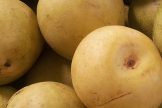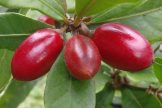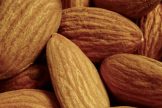
 Important note about plant availability. Important note about plant availability.There are hundreds of factsheets on our website provided for your information. Not all plants will be available at all times throughout the year. To confirm availability please call (03) 8850 3030 and ask for the nursery. |
Pears are one of the most versatile fruits around, whether you use them fresh, baked, poached, grilled, barbequed, sautéed, sliced into a salad, juiced or dried, they are delicious and easy. Used and cultivated for thousands of years, they have one unique characteristic: unlike most fruit, pears improve in both texture and flavour after they are picked. If left to ripen on the tree the texture can become gritty. Pears are high in fibre, a good source of vitamin C and a good Low GI food.
Pollination
With a few notable exceptions (discussed below) pears require two different varieties to fertilise each other. Pears fall into flowering groups: Early, Mid, Late and Very Late. A simple rule is that a pear variety will pollinate with another variety within its own group or with one in an adjacent group. The trees don’t need to be immediately adjacent, a suitable variety next door will do the job. Trees just need to be within a bees flight.
The exceptions:
Sterile pears: A few pears are sterile and require a minimum of two other pollinators around them, nor will they act as pollinators.
Self-pollinating: A few pears are self-pollinating, and will produce a fair crop on their own. However, bearing always improves with a cross pollinator.
Partially self-pollinating: If spring conditions are excellent, then these trees will be self-fertile to some degree, however if it is a poor spring, then the trees definitely need another pollinator for fruit set.
Pear Varieties
Buerre Bosc
Brown skin, yellow-white flesh, juicy, sweet, gritty texture. Use for fresh fruit, drying, preserving and cooking. One of the best all rounders for cooking, perfect baked in tarts, poached in honey or red wine or pan fried. Stores well.
Matures: Late February to March.
Pollinators: Nijisseili (20th Century), Red D’Anjou, Sensation, Williams Bon Chretien (syn Bartlett), Winter Nellis
Buerre Hardy
Introduced in the 1820s from Boulogne in France.
A medium sized traditional French Pear with all the floral flavours, melting sweet juicy flesh that you expect from a French pear. Roundish in shape with a russeted deep orange brown skin, the creamy flesh is fine, juicy and full of flavour. Beautiful fresh but also cooks well. Good regular cropping and heavy bearer.
Matures: March
Buttira Precoce Morettini
Pollinators: Lemon Bergamot, Nijisseili (20th Century), Williams Bon Chretien (syn Bartlett), Josephine De Malines, Packham’s Triumph
Corella
Small greenish yellow fruit with a red blush. Good flavour, greaqt eaten fresh and can be eaten while firm. Keeps Well
Matures: Late Season, March to April
Pollinators: Packham’s Triumph, Ya Li
Flemish Beauty
Bred in Belgium in the 1820s. As the name indicates: a very attractive pear. A red/pink blush over a creamy green skin and a lovely shape that sits nicely in your hand. Juicy dense white grainy flesh with an excellent sweet flavour. Keeps well, becoming sweeter and more aromatic. Originally called ‘Sweetmeat of the Woods’. The trees are hardy, vigorous and very productive. Thinning may be needed to increase fruit size.
Matures: March
Geishirtle
Pollinators: Sensation, Williams Bon Chretien (syn Bartlett)
Gin (Perry Pear)
This centuries old perry pear is used exclusively for perry (pear cider). Easier to grow than other perry pears with good disease resistance and a longer milling period once harvested. Has medium acid, medium tannin and makes good quality perry. Almost round smallish pears with green skin and an orange flush. Can be heavy (sometimes biennial) cropping once it gets going.
Matures: February March
Glou Morceau
Also called ‘Beurré de Hardenport’ and ‘Beurré de Arenberg’. Bred in Belgium. The name Glou Mourceau translates to dainty or delicious morsel, an apt name for this pear. A delightful small to medium dessert pear in the traditional fashion with classic melting fine and juicy flesh. Rich and sweet flavour. Very pretty with a little orange blush over the pale green background colour. Turns more yellow as it ripens, hangs well on the tree. No russeting. Good regular cropping.
Matures: March April
Josephine ( J. De Malines)
A moderate cropping variety from Belgium, with excellent keeping qualities. Used for fresh fruit, drying, cooking, preserving and juice. Summer pruning may be required to limit vigorous upright growth. More fruit is produced on horizontal growth. A small to medium, conical shaped fruit with greenish-yellow, partly russeted fruit, with an outstanding aroma and sweet, soft, juicy flesh. Mid to late season maturity.
Pollinators: Packham’s Triumph, Vicar of Winkfield, Winter Nellis (known to be incompatible with Sensation, Williams Bon Chretien (syn Bartlett))
Lemon Bergamot
Pollinators: Buerre Bosc, Josephine De Malines, Williams Bon Chretien (syn Bartlett)
L’Inconnue
Pollinators: Beurre Bosc, Packham’s Triumph
Packham’s Triumph
An excellent dessert pear of medium to large size, that can be very productive and hangs well on the tree. Bred in Australia in the early 1900’s. Refrigeration is necessary for about 14 to 21 days for the fruit to ripen satisfactorily. A medium-large, green pear, that ripens to lemon-yellow and becomes juicy and smooth. A firm, white fleshed pear, with rich, very good flavour. Excellent storage qualities. Good for fresh eating, juicing, drying and preserving. Summer pruning may be required to limit vigorous upright growth. More fruit is produced on horizontal growth.
Matures: mid-season, late February to early March.
Pollinators: Corella, Josephine De Malines, L’Inconnue, Nijisseili (20th Century), Vicar of Winkfield, Winter Nellis
Paradise
This variety has small sweet pears on a large sized tree. A new release variety introduced by Flemings. Small sized pears with crisp sweet white flesh.
Red D’Anjou
Pollinators: Beurre Bosc, Williams Bon Chretien (syn Bartlett)
Sensation
A distinctive bright crimson and gold skin. Creamy white, smooth texture, tender and moderately juicy flesh. Some branches may revert back to green skin. Use for fresh fruit, juice, drying, preserving and stewing.
Matures: Early to mid February.
Pollinators: Self Fertile, however will do better if pollinated with Beurre Bosc, Chojuro, Geishirtle, Hosui, Nijisseili (20th Century), Vicar of Winkfield (known to be incompatible with Williams Bon Chretien (syn Bartlett))
Trixzie Pipsqueak Dwarf
This is a great option for smaller gardens and can also be grown in pots. 1.5 x 1.5m Pipsqueak produces regular sized fruit on a compact or midget sized tree. The fruit is of great quality and has a green skin and juicy flesh.
Pollinators: Self fertile.
Vicar of Winkfield
Pollinators: Josephine De Malines, Packham’s Triumph
Williams Bon Chretien (syn Bartlett)
Clear yellow skin. White, firm, fine-grained juicy, sweet and tender flesh. Use for Fresh fruit, drying and preserving, stewing and juice.
Matures: Late January to mid February.
Pollinators: Partially Self Fertile, better with Beurre Bosc, Buttira Precoce Morettini, Chojuro, Geishirtle, Hosui, Nijisseili (20th Century), Red D’Anjou (known to be incompatible with Josephine De Malines and Sensation)
Winter Nellis
Pollinators: Beurre Bosc, Josephine De Malines, Packham’s Triumph, Sensation
Ya Li
Oblong, large medium sweet and acid flavours, juicy, white flesh, green and yellow skin
Matures: Late season, March – April
Pollinators: Corella
2 Way Multi-Graft: Packam’s Triumph / Josephine
Packam’s Triumph: Large fruit, delicious flavour.
Josephine: Juicy, delicate flavour. Use for fresh fruit, juice, drying and preserving.
Matures: Late February to April.
2 Way Multi-Graft: Williams (partially self fertile), and Packham’s Triumph.
Two popular varieties on the one tree. Excellent choice for those with limited space. Williams – White finely grained flesh, sweet and with good flavour.
Packham’s Triumph – White flesh and green skin. The flesh is firm and finely textured with excellent flavour and lots of juice.
3 Way Multi-Graft, European: Beurre Bosc, Williams (WBC) and Packham’s Triumph
Cross pollinating combination. The three most popular pears on the same tree. Great for those with small gardens.
Summer pruning may be required to limit vigorous upright growth. More fruit is produced on horizontal growth.





